What are magnifying glasses and how to choose them?

Magnifying glasses - with and without illumination, folding and other models - have gained great popularity among lovers of needlework and owners of home workshops, jewelers and beauticians. Such accessories help to expand the field of view, improve visibility. A detailed overview of the options available will help make choosing magnifying glasses for working with small objects easier and faster.
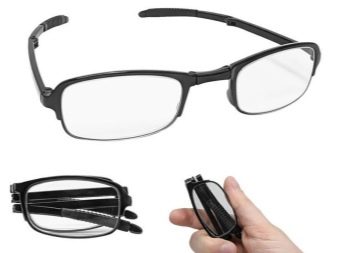

general description
Magnifying glasses are special devices suitable for people with normal vision, myopia or farsightedness. They do not correct vision, but are suitable for working with small objects or details. Professional magnifying devices are equipped with frames with adjustable mounting parameters and interchangeable lenses.

With them, you can change the degree of approximation of the object in question - the maximum values reach 160%.
Unlike ordinary glasses for correcting vision, magnifying glasses are not suitable for constant wear. They can only be used when doing small jobs, handicrafts, or reading text that cannot be viewed in other ways. In professional activities, such magnifying glasses are used by jewelers, specialists in the field of radio electronics, watchmakers, and engravers.
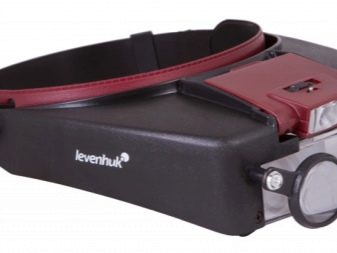

Ordinary people also note certain advantages of magnifying devices for home use.
-
Reducing eye strain when performing small jobs.
-
Versatility. You can use the devices even when wearing corrective glasses or contact lenses.
-
Convenience of fastening. You can choose comfortable retainers that are suitable for people of different professions and occupations.
-
Optimal magnification. You can find devices with interchangeable lenses that change the degree of proximity.
-
Freeing hands.Unlike a regular magnifier, glasses do not need to be held constantly; some models are even equipped with illumination.


The disadvantages of such devices are relatively few. The main problem is the low quality of such products. Their strength is minimal, and plastic lenses are easily covered with scratches, rubbed off, ceasing to perform their functions.
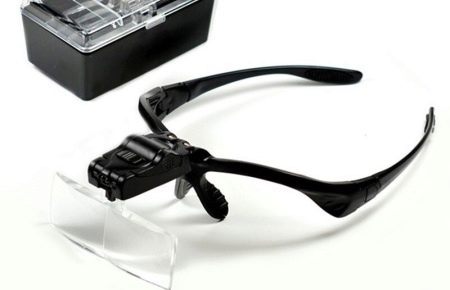
Some devices are additionally equipped with backlighting. It works autonomously from replaceable batteries. And also some models support changing the angle of inclination of the lens. In this case, you can adjust the viewing angle, use only 1 eyepiece or 2 of them at once.

Views
All types of magnifying glasses can be divided into groups, taking into account the peculiarities of their design. Such magnifiers can be one-piece or with interchangeable lenses. The first option looks more like classic glasses. The second is variable, lens holders may vary depending on different fixing methods. The basic classification is worth exploring in more detail.


By type of attachment
Manufacturers produce several design options for such glasses at once.
-
One-piece, with a single lens unit. They are complemented by temples with a temple and a silicone nose rest. The magnification is usually not too high.
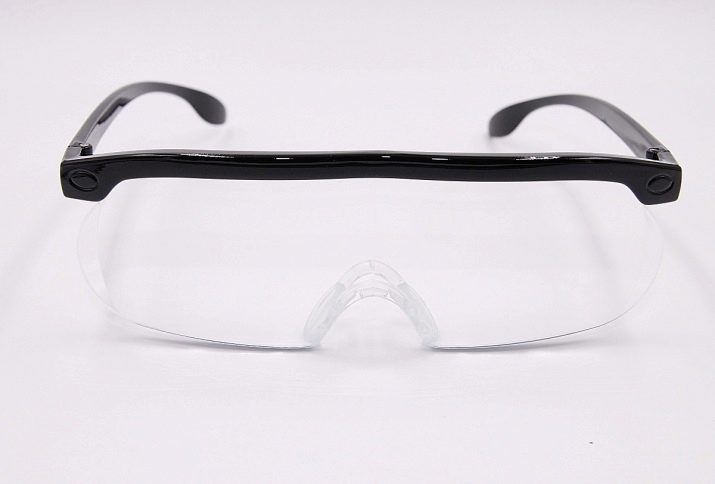
- Foldable pocket. They can be supplied with or without a case, equipped with telescopic arms. They are most similar to ordinary glasses, but with a certain degree of magnification.

- With elasticated rim. They are put on the head, encircling it with a ribbon. This is a convenient option for those who are often forced to carry out various types of small jobs.
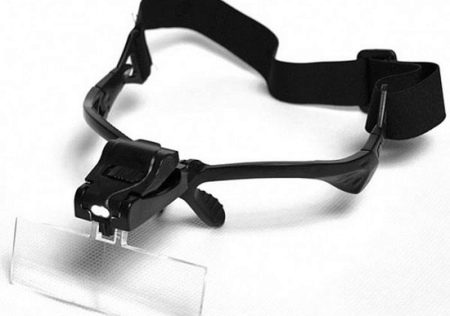
- In the form of a clothespin. It attaches to the visor of the headgear for optimal visibility. May look like a transparent visor with magnifying properties.

- Professional, head-mounted. They are made of hypoallergenic plastic and have an adjustable rim. Most often they are used in the medical field, cosmetology, when creating tattoos and eyelash extensions.

Most modern devices related to magnifying glasses have a fairly simple design. They are focused on use in everyday life, as convenient as possible, and take up little space.
Backlit and unlit
Magnifying glasses are available in 2 versions: without illumination and with built-in LED elements. The first category of such devices belongs rather to the category of corrective devices, which make it possible to see small objects in natural daylight. These models are equipped with a comfortable frame with a special support for the nose and temples-temples. It is a good choice for seniors, handicrafts lovers, philatelists.
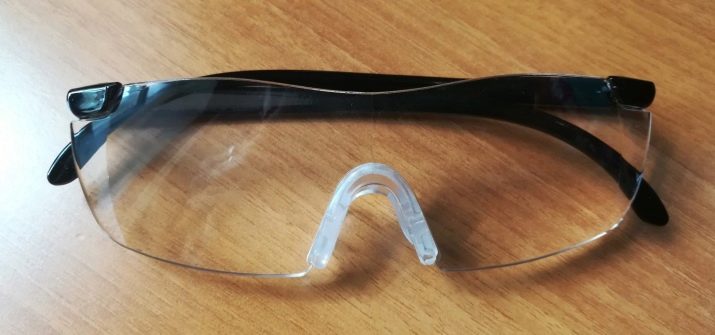
Illuminated magnifying glasses have more professional use. They are heavier and more massive due to the use of battery power sources. The backlight is used directionally, concentrated on the working area. Usually, such models are made folding or supplemented with head restraints.

Top Models
The rating of the best magnifying glasses - with a set of lenses for replacement or one-piece, in the form of a single design - will help you make the right choice when looking for a suitable model.
-
Mikmed 350R. Functional working loupe glasses used in the medical field. Magnification from 3.5x and excellent optics allow achieving a full view of the surgical field without distortion. The model is very lightweight, does not tire the head even when worn for a long time.
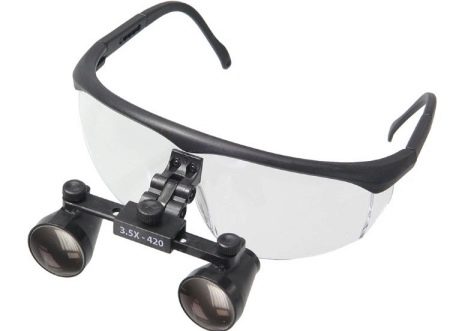
- Eschenbach maxDETAIL. Professional magnifying glasses of one of the leaders of the European market. The German brand offers for use a model with glass lenses and a plastic lightweight body. The model easily adjusts its performance and is focused on the medical field of activity. The magnification reaches 40 diopters.

- Kromatech MG9892B. Modern magnifying glasses from one of the market leaders. The model is suitable for conducting professional activities, capable of providing an increase of up to 25 diopters.The device has a built-in illumination and interchangeable lenses in 5 sets with different magnification factors. The stylish design and low weight of the device give it obvious competitive advantages.
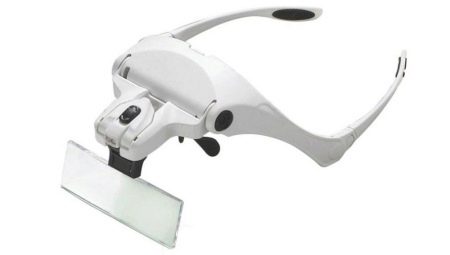
- Levenhuk Zeno Vizor G7. Professional tool for jewelry work, soldering radio components. Magnification up to 25x, illuminated lenses provide full visibility even in difficult visibility conditions. The plastic construction is very light, supports the adjustment of the location of the main elements to suit the individual needs of the user.

Battery power ensures complete autonomy in the operation of the device.
- Veber 7102L. A set of magnifying glasses with several lens options. This device is similar to classic theater binoculars, but much more convenient to use. The model is suitable for viewing objects at a distance or near, it supports precise adjustment, but is quite limited in functionality.

- Bestex MG81001-A. Backlit model with comfortable headband. Additional lenses are placed in an individual case, a visor-mount protects the eyes from sudden changes in light and shadow. The LED elements are located quite high, so the model is not suitable for working in complete darkness - the working area will not be brightly lit enough.

- Levenhuk Zeno Vizor G0. Functional model with bracket attachment and headgear clip and large, one-piece viewing area. The set includes 3 types of lenses with different magnifications. The lens tilt parameters can be changed.

- Kromatech MG9892G / GJ. Professional magnifying glass with variable magnification from 10x to 25x and built-in headlight. The binocular design is convenient for long-term work with small details, does not tire the bridge of the nose.

The illumination requires the use of battery power supplies, the distance between the eyepieces can be adjusted individually.
-
Levenhuk Zeno Vizor G1. The original model with interchangeable lens position - the eyepieces can be raised or lowered, used separately from each other. Despite this versatility, the model is quite cheap. The 20x magnification facilitates close examination of the smallest details. The model has a built-in backlight.

- laboCOMFORT. The model of magnifying glasses with a three-fold magnification of the image is considered professional, well suited for working with radio parts, for soldering, and jewelry. The backlit frame has a comfortable soft headrest, the high-strength plastic lenses do not scratch, retain their strength under shock loads.

- Bestex MG81001-A. Model of glasses-magnifier with interchangeable lenses and illumination for home use. The maximum magnification reaches 25 diopters. The device is equipped with a comfortable headband with a silicone pad. All materials are impact-resistant, replaceable lenses are placed in a special case.

- LPO-1. Basic home model, as similar as possible to ordinary glasses. A lightweight polymer frame is attached to a pair of clear 1.6 diopter lenses. Such a device is suitable for sewing, reading small print, and other types of work, it can be combined with contact lenses.
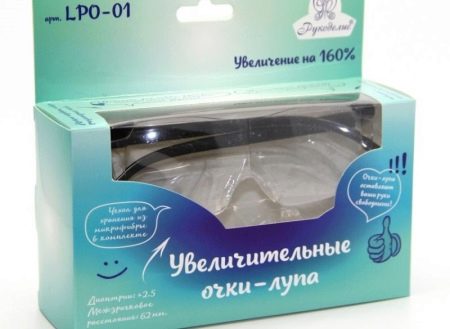
- "I see everything". Household model of magnifying glasses with low magnification. Produced under the Top Shop brand. Provide ease of use due to anatomically comfortable temples and universal center-to-center distance. An increase of 160% makes it easier to do handicrafts or read small print.

- Zoom HD. The products of the Chinese manufacturer are focused on household use. Outwardly, the model resembles ordinary glasses, it is suitable for use by the elderly or lovers of handicraft, radio, jewelry art with normal vision.

- Leomax Big Vision. Magnifying glasses of this company are also made in the form of classic glasses. They give an increase of 160% and are made of plastic - flexible and not very durable.The universal temples and nose bridge are not adjustable. May be supplied complete with transport case.

A review of the best magnifying glasses helps to fully appreciate the whole variety of such accessories, to make sure of their usefulness and functionality.
Nuances of choice
The selection of suitable loupe glasses is very important for their comfortable subsequent use. Since such accessories are not suitable for the visually impaired as an alternative to conventional diopters intended for constant wear, you need to focus on their real performance parameters.

Simple guidelines will help you choose the right magnifying glasses correctly.
- The main focus is on weight. The lighter the devices are, the less strain on the bridge of the nose and ears will be. Professional models usually have a comfortable head mount.
-
Functionality matters. Built-in autonomous illumination, adjustment of the distance between the centers of the lenses, changing the position of the mounts - all this turns a simple accessory into a device suitable for professional activities.
-
Replaceable lenses as an advantage. If the device is supplied with additional elements that allow changing the magnification ratio, this will significantly expand the possibilities of its use.
-
The magnification is the main factor. The higher it is, the finer details and elements can be seen. A small increase will be enough for an elderly person to sew or embroider, read newspapers without ordinary corrective glasses. Professional models have a magnification factor of the image in the lens from 5 to 40.
-
Adjustment according to individual parameters. Usually, with its help, you can change the length of the temples, the distance between the lenses and the bridge of the nose, and direct the eyepieces at the desired angle.
-
Working distance. It determines in what approximation it will be possible to work with small parts or tools. Models with a short working distance are suitable for reading. For professional activities, you will need options with a large distance.
-
The materials of manufacture determine the service life. In professional magnifying glasses, especially medical ones, they use exclusively glass lenses and flexible polymers that can withstand significant loads. Cheap household models are produced from polyurethane, which breaks and abrades when in contact with hard surfaces.
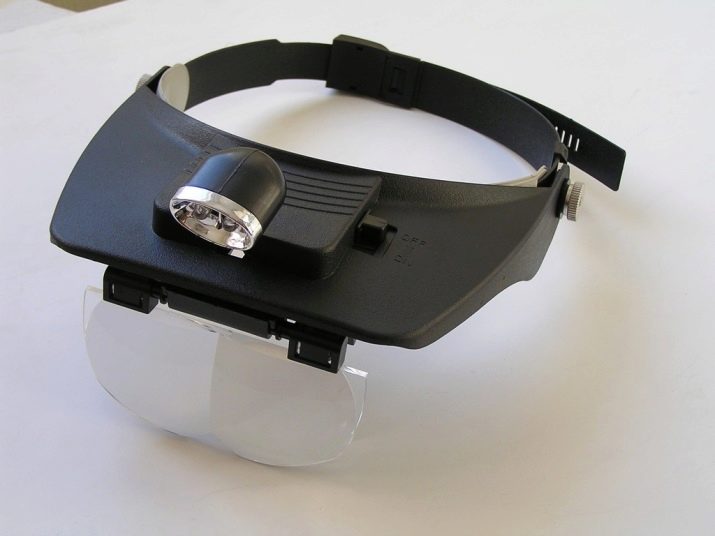





The middle category assumes the use of lenses made of acrylic polymer, which are more durable.
All these characteristics are important when choosing a magnifier for the elderly or for those who often do small jobs. With the help of suitable magnifying glasses for soldering or for handicrafts, you can easily expand your view, detect the smallest defects on parts and materials. Devices without interchangeable lenses will be indispensable for embroidering patterns with dark sequins, beads, bugles on the same background, for other small household chores. More complex ones are suitable for conducting professional activities in various fields.










